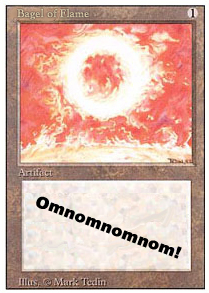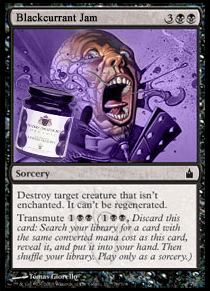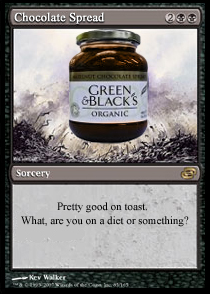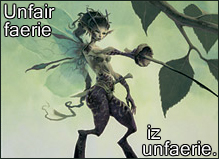
Sometimes, drafting gets a little out of hand in our house. This isn't the fault of Wizards of the Coast. It's the fault of our local supermarket who sell mixed packs of mini Danish pastries. My girlfriend and I then have to work out some way of splitting the six between the two of us. Cutting pastries in half is possible but messy. They're small enough that a substantial fraction of the pastry is lost during cutting. So we draft them.
To begin with, I adopted the obvious strategy of simply picking the pastry I liked best at each pick. That might seem obviously optimal, but in fact it isn't. I discovered this one morning when I was half asleep, mispicked and ended up with a better breakfast as a result. The reason? Because it turns out my girlfriend likes the jam Danish a lot more than I do and I like the vanilla Danish a lot more than she does. So my best strategy is to first-pick the cinnamon Danish and the vanilla one will still be in the pack when it returns to me.
"I win at breakfast!" I announced to my cat.
"But lose at life," said the cat, who was mostly cross at the nature of her own breakfast.
"Even better," I continued enthusiastically. "I can now transfer my breakfast tech back to real drafting and win at that too!"
"There's nothing 'real' about drafting Magic cards," the cat pointed out, "and besides, I have no interest in draft. I'd much rather take my chances with a random Sealed pool than have my success depend on getting inside the heads of the players to either side of me. At least on XBox Live you get to shoot all the sexist, racist, cat-hating lowlifes."
"Are you talking about signalling? Never mind that. At its heart, draft is about card evaluation. Understanding how to exploit the power of cards that others underrate."

The food of champions!
"He can do it to some extent, but there's plenty of scope for improvement. He still uses BREAD."
"Where real drafters prefer bagels?"
"It's an acronym. It tells you what order to prioritise draft picks in. B for Bombs, R for Removal, E for Evasion, A for Attackers and D for...well, nobody's quite sure what it's for, but it doesn't matter because those are the cards you never run."
"Sounds pretty trivial. So much for drafting."
"There's a catch, though. It's complete nonsense. You don't realise until you try to use it in a real draft. Midnight Charm is removal, whereas Rathi Trapper is clearly not an attacker, so Charm is the easy pick. Harmonize doesn't get considered, because card drawing isn't assessed. Broken Ambitions is never picked because countermagic doesn't get assessed. And cards like Whirlpool Whelm are out of contention unless you count bounce as removal. But if you do, then you'll end up first-picking Reality Strobe. And it's not clear whether some cards are bombs. Is Riftwing Cloudskate a bomb?"
The cat thought for a moment, then asked, "So why not teach Pat to evaluate cards properly? You're supposed to be his mentor. Or is the problem that you don't know the answer yourself?"
No, the problem is that card evaluation is too large a topic. Still, as Confucius once said to Churchill: a journey of a thousand miles begins with a single step.
Why the Format Matters
My cat was involuntarily in the capacity of audience for my first lecture on card evaluation. My girlfriend had made good her escape, I had locked the catflap, and I was confident of at least one attentive listener.
"These Cheerios are Grizzly Bears," I declared, lining up Cheerios on both sides of the table.
"I always suspected as much," the cat muttered, as it settled in for half an hour of boredom.
"If both players have a deck of only Forests and Cheerios, then whoever draws more Cheerios will ultimately win. But now suppose there's a new card type added to the format. The Weetabix is big compared to a Cheerio, and if blocked by three Cheerios it will trade with two, giving card advantage to its controller. But Weetabix are Uncommon, so most of each deck is still composed of Cheerios. Each player will run as many Weetabix as they can get."
The cat, none too interested in my Magic-related commentary, was warming to the idea of making a huge mess all over the table with various breakfast components and began making plans for the rest of Breakfast/Lunch/Dinner block.
"Now suppose we add Blackcurrant Jam to the format," I said, lining up two of the miniature jars I had received for Christmas (my relatives having long ago worked out that anything edible meets with approval). "Blackcurrant Jam is spot removal that takes out any creature, but only at Sorcery speed. Don't worry about the mana. Just assume it's castable. How good is it?"
"Don't much like jam," complained the cat, deliberately missing the point.
"Imagine it's mackerel jam then, if that helps. How good is the effect?"
"Not as good as a Weetabix, but better than a Cheerio," replied the cat, who could never resist a chance to be right about something.
"Right! So here comes the clever bit. Suppose we change our set so that Weetabix is now a Common, Blackcurrant Jam is a Common too and we bring in a new card at Uncommon: Cinnamon Danish, which can tap to destroy any of the cereal creatures. Now this changes our valuation of the Blackcurrant Jam. It's now better than a Weetabix, because the key to winning in the new format is to keep the opponent from untapping with a Cinnamon Danish in play. Or if they get one, to eliminate it as soon as possible."
"Feeeeaaaar the Danish!" warned the cat, unhelpfully. It nudged the cinnamon Danish incrementally towards me in a menacing manner.
"This experiment," I continued, ignoring the cat, "tells us something important about removal. It tells us that its value is critically dependent on the format. The question is therefore not simply how to evaluate removal, but how to evaluate the whole format in order to assess the removal."
"Sounds a lot like you've turned an easy question into a hard one," the cat complained.
"Hard to answer precisely, perhaps, but that's not really the aim. Late in the lifespan of a format, experience will take over from theory. It's when a format is relatively new that theory matters the most, or for less-experienced players. Also, if we look at a few examples, we can establish some rough guidelines which make things easier..."
Our basic rule at this point is that removal is better than the best card you can be confident that you will see on the other side of the table, but not as good as more powerful cards that you will only see occasionally. This is the underlying logic behind the initial "BR" of "BREAD" - pure removal can never be better than the best thing you want to hit with it.
A quick warning: for this basic rule, we only compare the creature as it exists in play. So this does not make Eyeblight's Ending better than Mulldrifter because the "draw two cards" is already done and dusted by the time removal can target the creature.
Example 1 - Strawberry Jam
"OK, Strawberry Jam is an Instant that kills only Cheerios. How good is that?"
"Not great," replied the cat thoughtfully, "but it is better than a Cheerio because it can be used mid-combat to take out one of three Cheerios blocking a Weetabix. Not that any decent player would walk into that trick."
"Partly," I countered, "that's because our format is artificially simple. There are two key factors in evaluating Strawberry. First, how much does it matter that it only removes small things? The answer is: we can apply our basic rule as before, but this time considering only the small things in the format. Because our Breakfast format has only Cheerios, the Strawberry Jam is not exciting. But suppose we add Milk Carton Lids to the format, which are like unblockable Cheerios that can't be targetted by the Cinnamon Danishes. Then, suddenly, Strawberry Jam gets way better. As for Instants...it's much better for removal to be Instant-speed since it increases its range of applications and improves your deck's tempo. A more detailed analysis of Instants I'll save for later, though."
Example 2 - Raspberry Jam
"Next, Raspberry Jam deals three at Instant speed, which already kills anything except Weetabix and can also target players for three. How good is that?"
"Very good. Possibly the best card in Breakfast so far."
"Ooh, controversial! Surely Cinnamon Danish is better?"
"Well, that depends on rarities and mana costs. That the Danish basically won't stay in play in this environment is the problem. You always want to hold removal back for your opponent's Danish until the last possible moment. What makes Raspberry so good is that if you have two cards in hand, then the opponent has to worry about going to six in case you have double Raspberry. It can take out a Danish or a Milk Lid; and if you have to, you can take out a Weetabix with this and a Cheerio."
And this is the key point about removal which makes it so confusing to evaluate. Very good players value it more highly than not just beginners but even intermediate players. This is not just for its raw power, it's also for flexibility. The top players expect to win 75% or more of their matches, not 50%. To achieve that, they need to rescue a lot of games that lesser players would lose. They don't care as much about having a Cinnamon Danish - although obviously they'll still pick them highly - because the games where they resolve one and it stays in play long enough to activate are games any player would win. They would rather that every game was as close as possible, because then they can outplay their opponents and win.

Always better? No - Apricot Jam costs
less.
"OK, so how about Apricot Jam - a card which takes out only creatures with at least four power?"
"In this format, it's not too exciting, though still playable. Again, it depends on rarities, but I don't want to draw more of these than my opponent draws Weetabix. That's virtual card advantage against me. Of course, part of that is because our experiments have resulted in a format full of removal."
"OK, so suppose all the removal is now Uncommon and Cinnamon Danish moves up to Rare."
"In that case, Apricot becomes quite good, though still not as good as Weetabix, because all it can ever do is trade with a Weetabix. Although, really, you ought to start considering mana efficiency, because a card like Apricot Jam is normally cheaper than the stuff it kills."
"Certainly, but that's a different issue. We'll come back to that later."
Example 4 - Peanut Butter
"Here's where things get really tricky. Peanut Butter is Sorcery speed and makes your opponent sac a creature. How good is that?"
"Well, it all comes down to rarities again. In this format it seems pretty weak because it's going to trade with a Cheerio most of the time."
"This is where draft differs from Sealed. If I can draft enough Strawberry Jam, I can blow away all your Cheerios - after all, you'll be running as few as you can - then Peanut Butter your good stuff and charge in for the win with my Cheerios."
"Really? Doesn't sound like it will work."
"Well, to be honest, I don't know. I'd have to try it out. But this is at the heart of what draft's all about. If you say a card is weak, that gives me a chance to build an effective archetype which gets good use from it."
Example 5 - Chocolate Spread
"Last example. Chocolate Spread Wraths the board. How do we evaluate that?"
"It's a bomb," the cat responded, rolling its eyes heavenward, "next question! Although actually, I question whether that really belongs in your evaluation of removal. It's really a whole different kind of card."
"I see your point, but I think it does belong. When the opponent has a creature which is a problem for you, removing everything is a valid way of removing it. And it's easy to call a card a bomb, but you'll have to justify that!"
"You have a simple advantage over your opponent when you draw it - you know it's coming. So you hold back your strongest creatures in anticipation, playing just enough to motivate the opponent to commit a lot of resources to the board."
"Why? What stops the opponent playing around the effect?"
"Nothing, to some extent. But if I can win next turn by overcommitting so long as you don't have Chocolate Spread, then it could be correct to do so, assuming it's a Rare and I don't know you have one in your deck."
"So the card actually becomes better due to being a Rare? Interesting."
"You can see it with cards like Sulfurous Blast and Final Revels. People play around them even at Uncommon."
"Still, that's not the main thing that makes the card good. All the other removal we've looked at goes 1-for-1 most of the time (the unwise gang-blocking of a Weetabix being the only exception). Mass removal offers the potential for card advantage. And that advantage becomes even more significant when we start considering mana costs."
"Long overdue," grumbled the cat.
Mana Costs
"Most big beatdown creatures are nothing like as efficient as Weetabix. Certainly not at Common rarity. Much more typical would be six mana. So let's look at the change to our format if we move Weetabix to Uncommon and add Granola Bar as a huge seven mana creature in the Common slot. What happens?"
"I win before you cast it," the cat replied smugly.
"No, but seriously, how does this affect our removal? For example, does Apricot Jam get better or worse?"
"Worse, obviously. Because the best thing to do against Granola Bars is to swarm round them or evade round them, which is hard to do if they appear early, but easy if they arrive late to the party. Makes Strawberry Jam way better, though. And Cheerios gain almost the most of all because suddenly they're relevant again. That, in turn, makes Peanut Butter much worse."
"So if Cheerios gain almost the most, what comes out on top?"

Planeshifted, with hazelnut.
"I think I'd rather have the fast deck still."
"Maybe so, but seven mana's a bit on the high side. In a real game, I'd have a high curve, but it would start lower than that."
That seemed like about enough discussion of Wraths to me. The cat's fondness for Constructed was getting in the way of the important stuff. After all, even if he had Chocolate Spread, he might not draw it; and it was very unlikely he'd have two.
"New question," I challenged the cat, "How much does the mana cost of the removal itself matter?"
"Who cares," the cat looked regretfully towards the locked catflap, "Wizards always make it cheap anyway. From a Limited perspective, that is."
"Not always," I countered, "What about Rain of Rust?"
(A quick note is in order here. Rain of Rust might not look like removal to you; but back in Mirrodin block, such a high proportion of creatures were artifacts that it was never short of targets.)
"The exception that proves the rule," the cat countered, "but yes, it took most players a long time to realise that was playable. The fact that the format was quite aggro-oriented didn't help..."
"Consuming Bonfire is a pretty good modern example. Outside decks with Smokebraider, it's often more expensive than whatever you're removing with it. In a format like triple-Lorwyn draft, that matters quite a lot."
"Why?" asked the cat suspiciously. "That sounds a lot like an special case before the ink is even dry on your general rule!"
Aggro, Control and Tempo
We have been talking so far about cards answering other cards. This is fine as a basic model of how things work, assuming that you build your deck with a healthy mana curve. However, even if your deck has a healthy curve, it's important for your removal to be as cheap as possible. There are two reasons for this.
First, you want your removal to be cheap so that you can cast it in time to stop the creature you plan to target. In the case of a beatdown creature, that means before you get too low on life. But the Breakfast format we have been using for our examples is still too simple. Consider instead a creature like Smokebraider. When you really want to remove it is before your opponent can use it to cast anything. A turn two Smokebraider can cast a turn three Mulldrifter - then the following turn cast an Aethersnipe - and that's just at Common. Your removal really needs to cost three mana or less to have a chance of killing the Smokebraider in time.
The other reason for caring about the cost of removal is tempo. If you spend seven mana casting a big thing and I spend three mana killing it, then I probably have spare mana to be doing other things at the same time. Ultimately, that makes all my other cards better because I can cast them sooner.
"Cheap removal is perfect for an aggro deck," I explain enthusiastically to the cat, "because it can continue to develop its board position whilst removing key defenders."
"It's no less essential to a control deck," the cat replied, taking the pro-control stance as usual, "because whilst a control deck has long game inevitability via card advantage, it needs early defences in order to survive long enough. The chances of my Merfolk protecting me from your Faerie swarm are pretty remote unless I can remove your Dreamspoiler Witches before they can kill all my Merfolk."
This is also why splashed removal is less powerful. If you don't find Black mana for your Nameless Inversion until turn eight, it doesn't matter that it only costs two. Your opponent's Huntmaster has by now done its work and flooded the board with Elves.
The cat wasn't really interested in my exposition, though. It was more concerned with coming up with more cards for the fictional Breakfast set. Eventually I gave up and decided to join in. Before we knew it, the entire morning had gone, we had our first seventy cards or so, and most of the contents of the kitchen cupboards were strewn across the table.
At that moment, the doorbell rang. It was Pat, who had woken up earlier than usual and decided to come and hang out with us. Eager to try out my theories on their real target audience, I explained all about evaluating removal to Pat. Unfortunately, it was all way too complex for him. That, and he found all the food very distracting.
"I like BREAD," Pat explained, "I can understand it. And bread, I like that too," he added, dropping a loaf of it into his huge toothy maw, complete with its plastic wrapper.
"Relax Pat." I pried the pepper mill out of his grip before he could eat it. "All you need is a summary."
The question of how good a removal spell is does not constitute an end in itself. We care about it only as a means to an end: deciding when it is correct to pick a removal card over some other attractive card in the same pack.
When to Draft Removal
Imagine we are comparing some removal card "removal" to some non-removal spell "card X"...
1) A removal card will on average be used against the most serious threat it can remove of those which the opponent plays. Therefore, if card X is about as good as the best threat you expect to play in an average game, it is better than removal. Because Uncommons and Rares tend to be stronger than Commons, we can deduce from this that very few Commons are better than unconditional removal.
2) For conditional removal, rule one applies in modified form. Compare card X to the most powerful card played in an average game which the removal in question can remove. It is important not to make the error of asking yourself whether the removal could remove card X. That is not relevant.
3) If removal has a high mana cost, this is simply a special case of conditionality. For example, Consuming Bonfire cannot be considered as removing Stinkdrinker Daredevil because the Giant player will likely have cast several Giants and gained a large tempo advantage by the time the Bonfire is cast.
4) If card X has a high mana cost, it should be considered correspondingly less of a threat. To get an intuitive feel for how much this matters, assess how you would feel if you knew before a match that this card was in your opponent's deck. A similar approach applies if card X is otherwise situational (for example Vinelasher Kudzu, which is weak in the late game).
5) Depending on how far you are through the draft, you may be considering removal with the expectation of splashing it, or considering card X with the expectation of splashing it. In both cases, a splashed card should be thought of as having a higher mana cost than its real value.
6) As a tiebreaker, assess the table. If you feel you are better than the average standard at the table, take the removal. This will help you to average out the threats you face to give you a better chance to outplay your opponent. If you feel you are weaker than the average, take card X. Because there are no wrong questions, only wrong answers!
Lorwyn, Morningtide, and Breakfast

What about Morningtide? In terms of targets, the set has plenty of things which want removing quickly. With the Banneret cycle enabling a variety of fast starts via cost reductions, evasive Rogues enabling the new Prowl mechanic, and the various Kinship creatures granting more bonuses the longer they stay in play, the incentives to use cheap removal for small creatures are increased. Unfortunately (or perhaps fortunately) the Common removal for Morningtide is either high cost or comes online late for other reasons. So it seems likely that the main impact will be to make the efficient Lorwyn removal rise even further in value.
Morningtide seems like a powerful set for Limited. With a high general power level but weak removal, it seems likely that Morningtide's removal will seldom be splashed; and that by the time you reach pack three, the main decisions will actually be between cards that help your tribal themes and powerful off-tribe cards.
As for our Breakfast set, we decided to abandon the project at the point where we realised we were seriously planning a shopping expedition to go and scout ideas for more breakfast foods. Besides which, we were starting to realise that growing a set outwards from some deliberately dull example cards was hardly a recipe for success.
We used the seventy-something cards we did have to construct a fake pack in order to test Pat's skills. The laptop listed off the cards and Pat began to read through the list making quiet "hmm..." noises.
"C'mon, what would you pick?"
At that moment my girlfriend came back in, glanced around at the devastation and looked at the freshly generated booster.
"Chocolate Spread, obviously."
"Why?" asked Pat, always eager to learn new tech.
"It's yummy," my girlfriend replied, shrugging, "do I need a better reason?"
Comments